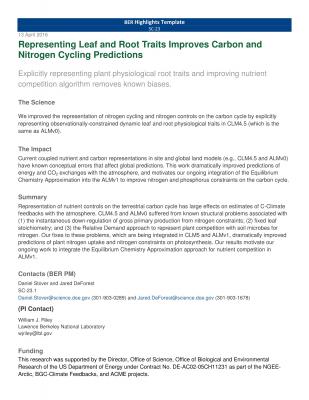Representing Leaf and Root Physiological Traits in CLM Improves Global Carbon and Nitrogen Cycling Predictions
We improved the representation of nitrogen cycling and nitrogen controls on the carbon cycle by explicitly representing observationally-constrained dynamic leaf and root physiological traits in CLM4.5 (which is the same as ALMv0).
Current coupled nutrient and carbon representations in site and global land models (e.g., CLM4.5 and ALMv0) have known conceptual errors that affect global predictions. This work dramatically improved predictions of energy and CO2 exchanges with the atmosphere, and motivates our ongoing integration of the Equilibrium Chemistry Approximation into the ALMv1 to improve nitrogen and phosphorus constraints on the carbon cycle.
Representation of nutrient controls on the terrestrial carbon cycle has large effects on estimates of C-Climate feedbacks with the atmosphere. CLM4.5 and ALMv0 suffered from known structural problems associated with (1) the instantaneous down-regulation of gross primary production from nitrogen constraints; (2) fixed leaf stoichiometry; and (3) the Relative Demand approach to represent plant competition with soil microbes for nitrogen. Our fixes to these problems, which are being integrated in CLM5 and ALMv1, dramatically improved predictions of plant nitrogen uptake and nitrogen constraints on photosynthesis. Our results motivate our ongoing work to integrate the Equilibrium Chemistry Approximation approach for nutrient competition in ALMv1.

